What is a Removal Strategy (FIFO, LIFO, FEFO, Closest location)?¶
Usually, Removal Strategies are defined in picking operations to select the best products, optimize the distance for the worker, for quality control purposes, or to first move products with the closest expiration date.
当需要移动产品时,Odoo会找到可分配给转移的可用产品。Odoo分配这些产品的方式取决于*产品类别*中定义的*删除策略*或*位置*。
仓库里发生了什么?¶
Imagine a generic warehouse plan, with receiving docks and areas, storage locations, picking and packing areas, and shipping docks. All products go through all these locations, but some rules, such as removal strategies, can have an effect on which products are taken for the pickings.
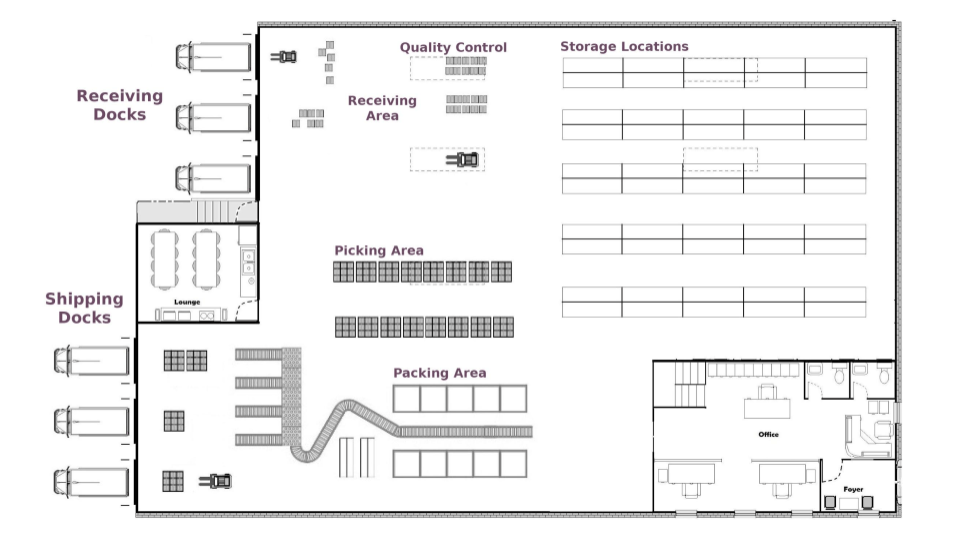
Here, vendor trucks unload pallets of goods at the docks. Then, operators scan the products in the receiving area with the reception date and, if the product has an expiration date, the expiration date. After that, products are stored in their respective locations.
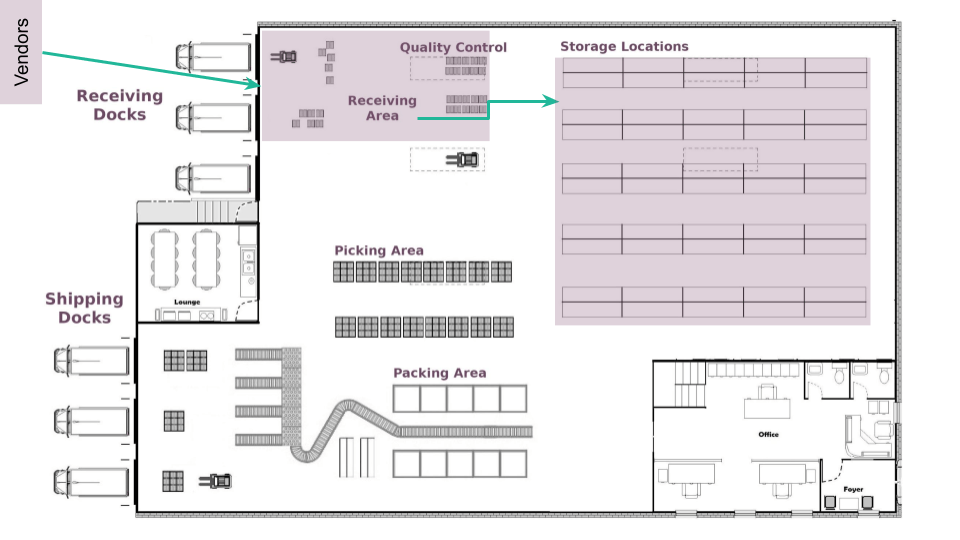
Next, several orders for the same product are made, but in this example, the goods weren’t received on the same day and they don’t have the same expiration date. In that situation, logically, sending those with the closest date first is preferred. Depending on the chosen removal strategy, Odoo generates a transfer with the products that fit the settings the best.
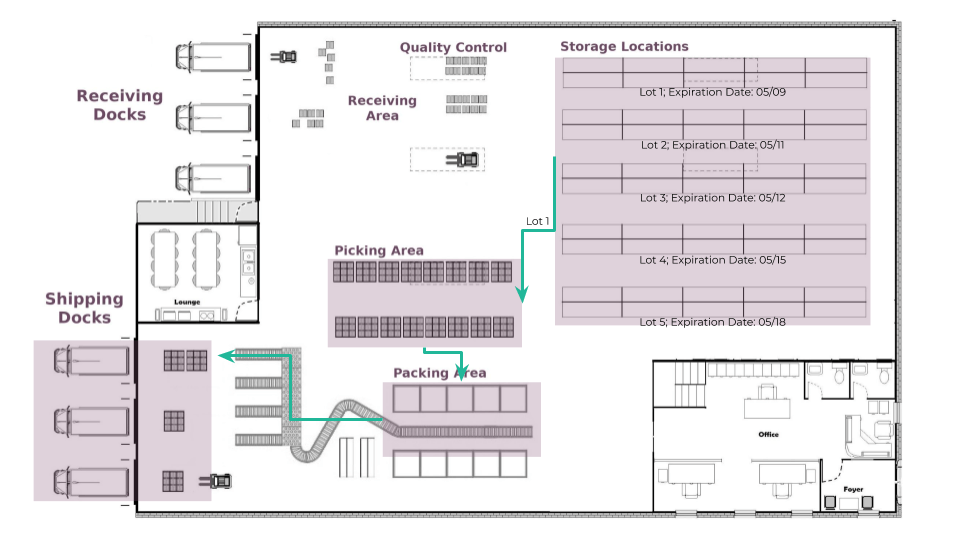
注解
To pick for delivery, the product’s lot/serial number can be found on the transfer form.
工作原理是什么?¶
先进先出(FIFO)¶
When using a First In, First Out (FIFO) strategy, a demand for some products triggers a removal rule, which requests a transfer for the lot/serial number that has entered the stock first.
For example, imagine there are three lots of nails in the warehouse. Those three have the following lot numbers: 00001, 00002, 00003, each with five boxes of nails in it.
00001 entered the stock on the 23rd of May, 00002 on the 25th of May, and 00003 on the 1st of June. A customer orders six boxes on the 11th of June. With the FIFO removal strategy selected, a transfer is requested for the five boxes of 00001 and one of the boxes in 00002, because 00001 entered the stock before the others. The box from 00002 is taken next because it has the oldest reception date after 00001.
So, for every order of a product with the FIFO strategy selected, Odoo requests a transfer for the products that have been in the stock for the longest period.
后进先出(LIFO)¶
Similar to FIFO, the Last In, First Out (LIFO) strategy moves products based on the date they entered the stock. Here, a demand for some products triggers a removal rule that requests a transfer for the lot/serial number that has entered the stock most recently.
For example, imagine there are three lots of screws in the warehouse. Those three have the following numbers: 10001, 10002, and 10003, each with 10 boxes of screws in it.
10001 entered the stock on the 1st of June, 10002 on the 3rd of June, and 10003 on the 6th of June. A customer orders seven boxes on the 8th of June. With the LIFO removal strategy selected, a transfer is requested for seven boxes of 10003 because that lot is the last one to have entered the stock.
Basically, for every order of a product with the LIFO strategy used, a transfer for the last lot to have entered the stock is requested.
注解
The LIFO strategy is banned in many countries and can lead to only having old or obsolete products in the stock.
先到期先出(FEFO)¶
The First Expired, First Out (FEFO) strategy is a bit different from the other two removal strategies. For FEFO, the expiration date is important, not the date the product entered the stock.
For example, imagine there are three lots of six-egg boxes (in this specific case, don’t forget to use units of measure). Those three lots have the following numbers: 20001, 20002, and 20003, each with five boxes in it.
20001 entered the stock on the 1st of July and expires on the 15th of July, 20002 entered on the 2nd and expires on the 14th of July, and 20003 entered on the 4th and expires on the 21st of July. A customer orders six boxes on the 5th of July. With the FEFO strategy selected, a transfer is requested for the five boxes of 20002 and one from 20001. The transfer for all the boxes in lot 20002 is because they have the closest expiration date. The transfer also requests one box from 20001 because has the next closest expiration date after lot 20002.
Basically, for every sales order of a product with the FEFO strategy, a transfer is requested for the product that has the nearest expiration date from the order date.
Closest Location¶
The Closest Location strategy is completely different from the other removal strategies. It is not related to the date of entry in the warehouse, but rather the location of the product. It is commonly used for products that do not deteriorate with time.
The aim is to avoid making the warehouse worker take a long journey to the bottom of the stock when the product is also located at a near location. This method is only available if the Storage Locations setting is on. The closest location is actually the one that comes first in the alphabetic order.
Use removal strategies¶
To differentiate some units from others, the units need to be tracked, either by lot or by serial number. To do so, go to . Then, activate the Storage Location, Multi-Step Routes, and Lots & Serial Numbers settings.
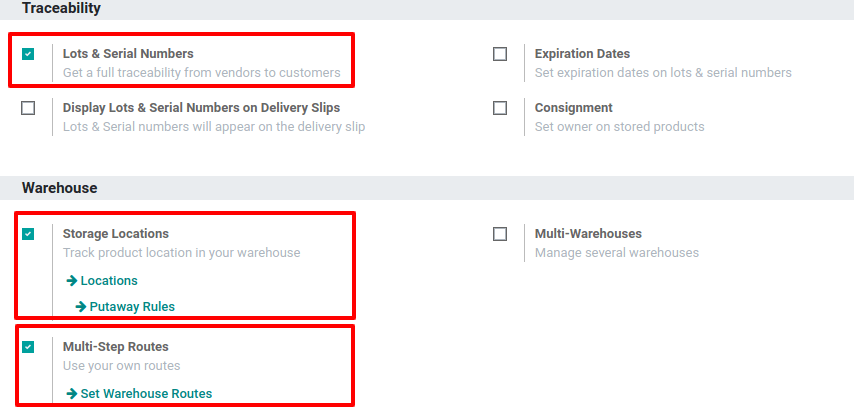
注解
To work with the FEFO strategy, also activate the Expiration Dates feature.
Next, go to to define the removal strategy on a product category.
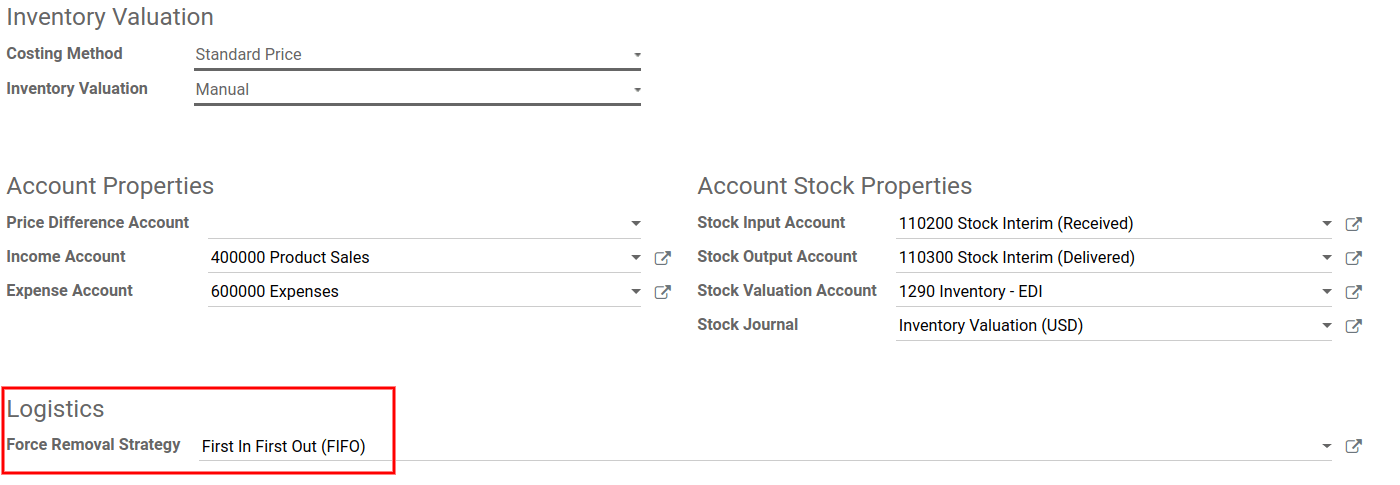
FIFO(先进先出)¶
As explained, a FIFO removal strategy implies that products stocked first move out first. Companies should use this method if they are selling products with short demand cycles, such as clothes, and to ensure they are not stuck with outdated styles in stock.
In this example, there are three lots of white shirts. The shirts are from the All/Clothes category, where FIFO is set as the removal strategy. In the stock location (WH/Stock), the user can find the three lots available.

Lot 000001 contains five shirts, 000002 contains three shirts, and 000003 contains two shirts.
As seen above, 000001 entered the stock first. Now, create a sales order of six white shirts to check that those products from lot 000001 are the first ones to move out.
On the delivery order linked to the picking, the oldest lot numbers should have been reserved thanks to the FIFO strategy.

LIFO (后进先出)¶
With a LIFO strategy, that’s quite the opposite. In fact, the products that are received last move out first. LIFO is mostly used for products without a shelf life.
In this example, let’s use the white shirts again to test the LIFO strategy. First, open the product category via and change the removal strategy to LIFO.

Then, create a sales order for four white shirts and check that the reserved products are from lots 000003 and 000002.

重要
Don’t forget that the LIFO strategy is banned in many countries!
FEFO (First Expired, First Out)¶
With the FEFO removal strategy, the way products are picked is not based on the reception date. In this particular case, they are dispatched according to their expiration date.
注解
For have more information about expiration dates, please have a look at the related doc.
By activating the Expiration Dates feature, it becomes possible to define different expiration dates on the serial/lot numbers that will be used in FEFO. These expiration dates can be set by going to .

从最早到最晚,根据移动日期选择范围。未定义移动日期的范围在具有移动日期之后拾取。
注解
其他日期仅供参考和报告之用。如果没有从库存中移动,超过到期日期的批次仍可能被选为交货订单!
To use the FEFO strategy, go to and set FEFO in the Force Removal Strategy field.

For this particular case, the stock has hand cream. There are three lots of them.
Lot / Serial No |
Product |
Expiration Date |
|---|---|---|
0000001 |
护手霜 |
2019/09/30 |
0000002 |
护手霜 |
2019/11/30 |
0000003 |
护手霜 |
2019/10/31 |
When a sales order for 25 units of Hand Cream is created, Odoo automatically reserves the lots with the closest expiration date, 0000001 and 0000003.
